Chapter 1: English legal system
Chapter learning objectives
Upon completion of this chapter you will be able to:
- explain the difference between civil and criminal law
- explain the structure and operation of the civil courts and tribunal systems
- explain the meaning of judicial precedent, ratio decidend and obiter dicta
- illustrate how the doctrine of judicial precedent works in relation to the civil courts
- explain how legislation is made and the doctrine of sovereignty
- set out the rules and presumptions used by the courts in interpreting statutes
- identify the concept of human rights as expressed in the Human Rights Act 1998 (HRA 1998)
- explain the impact of human rights law on statutory interpretation
- explain the impact of human rights law on the common law.
1 Definition of Law
The principles and regulations established in a community by some authority and applicable to its people whether in the form of legislation or of custom and policies recognised and enforced by judicial decision.
2 Types of Law
The English legal system distinguishes several types of law. The ones we will look at are:
- Common law and equity
- Private law and public law
- Criminal law and civil law
3 Common Law and Equity
Following the Norman conquest, English law has been described as a common law system. This was a system whereby a number of legal concepts from Norman law were incorporated into the English system. Judges would travel around the country and apply a mixture of precedent and common sense to build up a body of internally consistent law. However, this would sometimes result in harsh consequences.
Under common law the only remedy available was monetary e.g. damages.
To deal with the issue that damages are not always a suitable remedy, equity was developed two or three hundred years later after common law and introduced fairness into the English legal system.
4 Private and Public law
Within the English legal system, two distinct areas of law operate: private and public law. They both aim to create social order, but have a number of distinct differences.
Within public law, different categories exist. These include criminal law, constitutional law, administrative law, social welfare law and all deal with matters relating to the whole country.
Private law is concerned with the law enforced between individuals. This can include contract law, family law and other areas which deal with intellectual property rights (copyrights, designs and patents), land law (and the way in which it is transferred), probate (dealing with wills and how property is distributed after someone dies) and company law (which deals with the ways in which companies are created and rules regulating how they operate their business).
5 Criminal law versus civil law
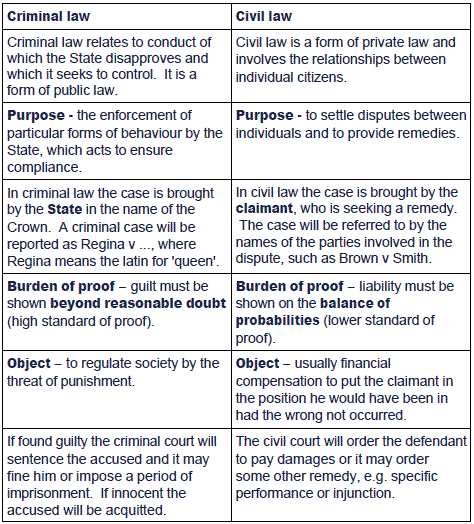

 Test your understanding 1
Test your understanding 1
(1)Which one of the following statements is correct?
AThe aim of the criminal law is to regulate behaviour within society by the threat of punishment.
BThe aim of the criminal law is to punish offenders.
CThe aim of the criminal law is to provide a means whereby injured persons may obtain compensation.
DThe aim of the criminal law is to ensure that the will of the majority is imposed upon the minority.

6 The court system
The main English civil courts
The following diagram shows the main civil courts. The term 'first instance' refers to the court in which the case is first heard. Appeals are heard in a different court. The arrows show the way a case will progress through the court system.
The House of Lords was replaced by the Supreme Court on 1 October 2009. This new court has assumed the judicial functions of the House of Lords. The Law Lords that used to sit in the House of Lords now sit as twelve Justices of the Supreme Court, with a President at its head.
The Supreme Court was established by the Constitutional Reform Act 2005. It was felt that there needed to be a separation of powers between the judicial functions of the House of Lords (to decide issues in relation to the law) and the legislative functions of the House of Lords (to make the law) to give assurance of the independence of the judges.
The Supreme Court is now in a separate building from the House of Lords and has its own appointment system, staff and budget.
The three-track system
When a claim is received, it will be allocated to one of three tracks for the hearing.
(1)The small claims track – deals with simple claims valued at no more than £5,000, an informal court.
(2)The fast-track – deals with moderately valued claims of between £5,000 and £15,000, expected to last no more than one day.
(3)The multitrack – deals with claims of over £15,000 and/or complex claims.
Note: the County court deals with all cases allocated to the small claims track, the majority of fast track and some multi track cases. All other claims are dealt with by the High Court.
Other civil courts
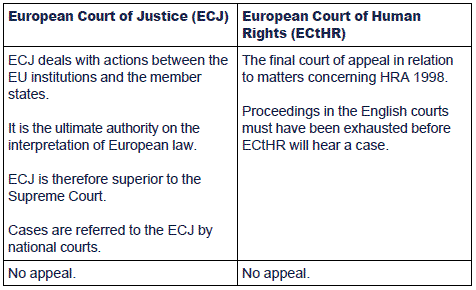
The main English criminal courts
Tribunals
Tribunals are also an important part of the English legal system and are an alternative to using the court system to settle a dispute.
In the past, tribunals had been created on an ad hoc basis to perform various judicial functions, for example Employment Tribunals and Asylum and Immigration Tribunals. The tribunals' members were a mixture of judges, lawyers, experts and laypeople, and were regulated by various government departments and bodies. Though these tribunals were supervised by and had rights of appeal within the UK court system, a reform was recommended to create a unified and simplified structure which was better integrated into the courts system.
The Tribunals, Courts and Enforcement Act 2007
The Act made various reforms with regards to tribunals in particular the structure of tribunals.
Section 1 of the Act recognises legally qualified members of tribunals as members of the judiciary of the United Kingdom who are guaranteed continued judicial independence.
Section 3 of the Act creates two new tribunals to which existing jurisdictions will be transferred, a First-tier Tribunal and an Upper Tribunal.
The First-tier Tribunal is divided into six chambers:
- General Regulatory Chamber
- Social Entitlement Chamber
- Health, Education and Social Care Chamber
- War Pensions and Armed Forces Compensation Chamber
- Tax Chamber
- The Immigration and Asylum Chamber.
The main functions of the Upper Tribunal are to
- take over hearing appeals to the courts, and similar bodies from the decisions of local tribunals
- decide certain cases that do not go through the First-tier Tribunal
- exercise powers of judicial review in certain circumstances ; and
- deal with enforcement of decisions, directions and orders made by tribunals.
There is a right of appeal to the Court of Appeal of England and Wales.
Some tribunals will still lie outside the new system.
Employment tribunals
Employment tribunals are established to hear disputes between an employee and their employer on certain statutory employment matters, such as unfair dismissal (see Chapter 4).
Employment tribunals are composed of one employment judge, plus two expert laymen who are drawn from panels representing both sides of the industry.
Appeals are to the employment appeal tribunal (EAT) and can only be made on a point of law.
The EAT is composed of one High Court judge, plus two or four expert laymen.
Court v Tribunal
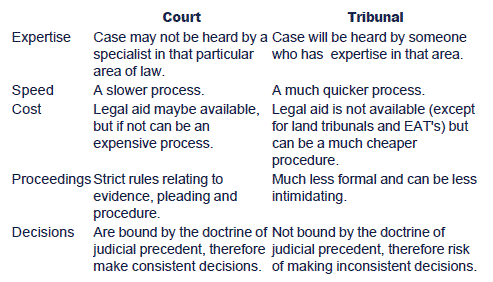
7 Sources of law
Overview
Case law
Throughout this text you will find examples of cases which have come before the courts. These cases are not simply examples of the way in which the law is applied; they also illustrate the way in which the law is made. The examiner expects you to learn the cases and to include them in your answers.
Case law can be subdivided into:
Common law:
- developed from local customs
- introduced the system of precedent (see below)
- the only remedy is damages
- may be rigid and inflexible.
Equity:
- developed as a petition by a party who felt the common law had led to injustice
- it is more flexible than the common law
- it introduced new discretionary remedies, e.g. injunctions and specific performance
- it is concerned with fairness and therefore will not be granted if there is undue delay in bringing the case or if the petitioner has himself acted unfairly, or where there is no mutuality (both parties should be able to bring a case).
Doctrine of judicial precedent
The system, adopted by the judges, of following the decisions in previous cases is called the doctrine of judicial precedent.
- Some precedents are binding (meaning they must be followed in later cases).
- Others are merely persuasive (meaning that a judge in a later case may choose to follow it but he is not bound to do so).
There are three factors to be considered in deciding whether a precedent is binding or persuasive:
- the hierarchy of the courts
- ratio decidendi and obiter dicta
- the material facts of the case.
The hierarchy of the courts
As a general rule, the precedents of higher courts bind lower courts, but not vice versa.
Ratio decidendi and obiter dicta
The ratio decidendi is the legal reason for the decision. It is capable of forming the binding precedent. It is a statement of law which is carried down to later decisions.
Obiter dicta are statements which are not part of the ratio, they are other statements made by the judges such as hypothetical situations or wide legal principles. They are persuasive rather than binding. This means that the judge can take the statement into account (and usually will) when reaching his decision, but he does not have to follow it.
Facts of the case
In order for a precedent to be binding on a judge in a later case, the material facts of the two cases must be the same. If they are significantly different, the precedent will be persuasive rather than binding.
When is a precedent not binding?
A precedent is not binding where it:
- has been overruled by a higher court.
- has been overruled by statute.
- was made without proper care (per incuriam).
- can be distinguished from the earlier case, i.e. the material facts differ.
Advantages and disadvantages of judicial precedent
Advantages
- Reaching decisions as a result of the doctrine of precedent makes the system consistent. It becomes easier to predict the result of litigation.
- It allows the English legal system to be flexible. Decisions can be adapted and extended to reflect changes in society.
- The law is clear. As it is only the ratio decidendi that is followed it is easy to see what law is being applied.
- Decisions arise from actual events, therefore the system is practical.
Disadvantages
- The law is very complex because there is a vast number of cases, and inconsistencies can arise. The same judgement may contain differing, and even conflicting, arguments making the precedent hard to understand and even harder to apply.
- The law can become rigid, leading to inflexibility and loss of development.
- Case law is reactive rather than proactive. Rather than dealing with issues in advance and stating the law, a case is considered and a decision made once a particular situation has arisen.

 Test your understanding 2
Test your understanding 2
(1)Which one of the following statements about the law of equity is untrue?
AEquitable remedies may only be awarded at the discretion of the court.
BEquity originally developed as a result of individual appeals to the King being delegated to the Lord Chancellor.
CEquitable remedies include damages, injunctions and decrees of specific performance.
DEquity will prevail in a case of conflict between it and the common law.
(2)Which part of a case decided by the courts is binding on lower courts dealing with the same material facts?
AObiter dicta.
BThe decision of the judge.
CThe ratio decidendi.
DAll of the above.
(3)Which one of the following is the highest court in England?
AThe Court of Appeal.
BThe Supreme Court.
CThe High Court.
DThe Crown Court.
(4)Which one of the following statements is untrue?
ADecisions of the Supreme Court (formerly the House of Lords) bind all lower courts.
BThe Supreme Court (formerly the House of Lords) is not bound by its own decisions.
CDecisions of the Supreme Court (formerly the House of Lords) override statute.
DAppeals can be made from the Supreme Court (formerly the House of Lords) to the ECJ.

8 Legislation
Types of legislation
Legislation falls into two categories:
- Acts of Parliament
- delegated legislation.
Acts of Parliament
Parliament consists of:
- the House of Commons
- the House of Lords
- the Monarch.
In order to become an Act of Parliament, a Bill must go through the following stages in both Houses:
- first reading - the name of the Bill and the its proposer is read out
- second reading - debate takes place on the principles of the Bill and it is then voted upon
- committee stage - a smaller number of MP's consider the wording of the Bill. This stage can last several months depending on the contentiousness of the Bill
- report stage - the Bill as amended by the Committee is reported back to the full House
- third reading - the Bill is read for the final time.
At the end of this process in both Houses, the Bill must receive the Royal Assent.
Note that an Act does not necessarily come into force immediately. Its provisions may take effect on a piece-meal basis. An example is the Companies Act 2006.
Doctrine of sovereignty of Parliament
Parliament is sovereign. This means that, in theory, it is only Parliament that can make new law and it can make any law it wishes. However it cannot pass an Act which can never be repealed.
The courts cannot question the validity of an Act. However, they must refuse to apply an Act that contravenes EC law.
Delegated legislation
Delegated legislation is made on behalf of Parliament. It consists of:
- statutory instruments: made by Government Ministers using powers delegated by Parliament
- bye-laws: made by local authorities
- Orders in Council: made by the Privy Council in the name of the Monarch on the advice of the Prime Minister.
Delegated legislation has a number of advantages:
- It saves Parliamentary time.
- It may benefit from access to technical expertise, thus leaving Parliament free to consider and debate the underlying principles.
- Flexibility – it is quick and easy to make and to change.
However, it also has a number of disadvantages:
- Its volume and lack of publicity means that it can be difficult to keep up with the changes introduced.
- It is criticised as being undemocratic as it is made without recourse to the elected House of Commons.
There are a number of means of controlling delegated legislation:
- Parliamentary – Since 1973 there has been a Joint Select Committee on Statutory Instruments, whose function it is to scrutinise all statutory instruments. They have the power to draw the instrument to the attention of both Houses on any number of grounds, but cannot do so on a ground which relates to the actual merits of the instrument or the policy it is pursuing.
- Judicial – The courts can challenge the validity of delegated legislation through the process of judicial review. It can be challenged on the grounds that the person making it has acted ultra vires, by exceeding their powers. If successful the court will declare it void and unenforceable.
- Human Rights Act 1998 – Delegated legislation is secondary legislation, therefore it can be declared invalid by the courts if it is incompatible with HRA 1998.

 Test your understanding 3
Test your understanding 3
(1)Which of the following statements is correct?
IIn the event of a conflict between equity and the common law, the common law prevails.
II An Act of Parliament can overrule any common law or equitable rule.
A(I) only.
B(II) only.
CNeither (I) nor (II).
DBoth (I) and (II).
(2)Which of the following is NOT a form of delegated legislation?
AOrders in Council.
BStatutory instruments.
CLocal authority bye-laws.
DActs of Parliament.

9 Rules of statutory interpretation
Introduction
The process by which judges assign meanings to ambiguous words or phrases in statutes is called the interpretation of statutes.
Judges can use certain aids, rules and presumptions to help them assign a meaning to a word.
Aids to interpretation
The courts can use the following aids to help them interpret a statute:
- the legislation itself (i.e. its definition section).
- judicial precedents.
- the Interpretation Act 1978 - the Act defines certain terms frequently found in legislation. The Act also states that 'unless a specific intention to the contrary exists, the use in a statute of masculine gender terminology also inlcudes the feminine, and vice versa'.
- the Oxford English Dictionary.
- Hansard (to see what was said in Parliament when the Bill was being debated). In Pepper v Hart (1992) the House of Lords established the principle that when primary legislation is ambiguous then, under certain circumstances, the court may refer to statements made in the House of Commons or House of Lords in an attempt to interpret the meaning of the legislation.
- sources of EC law. Since the United Kingdom joined the EC in 1972 they agreed to conform with existing and future EC law. One of the many sources of EC law is a Directive which generally addresses the member states and requires that the states take action within an indentified time period to change their own law. When in doubt courts may look to the Directive for guidance on interpretation.
- Human Rights Act 1998 (see section 6).
Literal rule
Words must be given their ordinary dictionary meaning, even if this produces an undesirable outcome.
Fisher v Bell (1961) – Under the Restriction of Offensive Weapons Act 1959 it was a criminal offence to 'offer for sale' a flick knife. A shopkeeper who displayed one in his shop window was held not guilty as the court chose to follow the contract law meaning of the word 'offer'.
Golden rule
Where the literal rule gives more than one meaning or provides an absurd result, the golden rule is used to ensure that preference is given to the meaning that does not result in the provision being an absurdity.
Adler v George (1964)
Facts: a conviction was challenged on the basis of what appeared to be a miswording in the Official Secrets Act (1920). This Act made it an offence to obstruct a member of the armed forces `in the vicinity of' particular locations, but not actually `in' those locations. The defendant was actually inside an Air Force base at the time of the incident, which he claimed was beyond the literal scope of the act.
Held: The words 'in the vicinity of' a prohibited place in the Official Secrets Act were held to cover the acts of the defendant which took place 'within' a prohibited place.
Mischief rule
Used to interpret a statute in a way which provides a remedy for the mischief the statute was enacted to prevent.
Gorris v Scott (1874)

Purposive Rule
This is a more modern approach. Here the court is not just looking to see what the gap was in the old law, it is making a decision as to what they felt Parliament meant to achieve.
Gardiner v Sevenoaks RDC (1950)
Facts: The purpose of an Act was to provide for the safe storage of film wherever it might be stored on 'premises'. The claimant argued that 'premises' did not include a cave and so the Act had no application to this case.
Held: The purpose of the Act was to protect the safety of persons working in all places where film was stored. If film was stored in a cave, the word 'premises' included the cave.
Eiusdem generis
General words mean the same kind of thing as the specific words they follow.
Powell v Kempton Park Racecourse Co (1899)
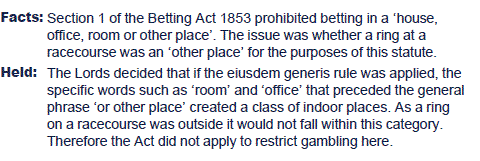
Expressio unius exclusio alterius
Where a statute seeks to establish a list of what is covered by its provisions, then anything not expressly included in that list is specifically excluded.
Presumptions
There are presumptions which will generally apply unless the legislation specifically states otherwise, for example:
- A statute will not bind the Crown.
- A statute cannot conflict with international law. An Act should therefore be interpreted as giving effect to international obligations.
- A statute does not have any retrospective effect.
- A statute does not alter the common law.
- A statute does not exclude the jurisdiction of the court.
- Legislation does not extend beyond the territorial jurisdiction of the UK.
10 Human Right Act 1998

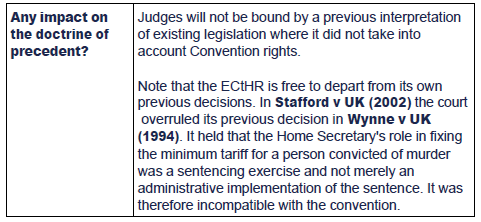
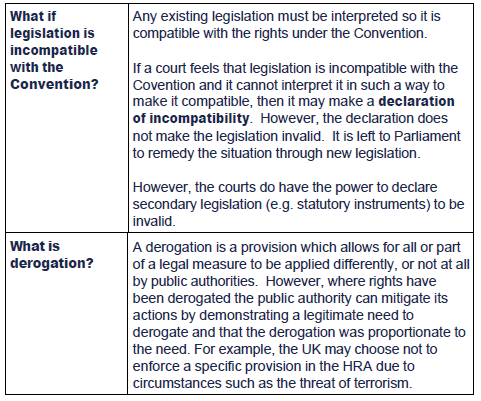
Bellinger v Bellinger (2003)
Facts: The House of Lords had to consider whether or not a male to female transsexual could be treated as a female under the Matrimonial Causes Act 1973.
Held: The court was unable to interpret the Act to allow the transsexual to be considered female. It did however issue a declaration of incompatibility.
The Gender Recognition Act 2004 addressed the issue in Bellinger v Bellinger (2003). The purpose of the Act is to provide transsexual people with legal recognition in their acquired gender. This is an example of the passing of a statute to put right a perceived unfair outcome of a case.
Mendoza v Ghaidan (2003)
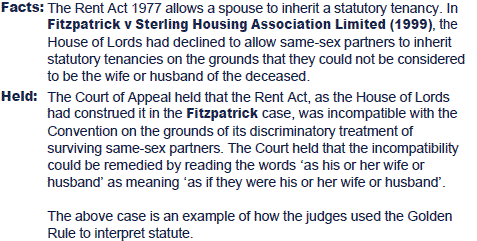
11 Chapter summary
Test your understanding answers

 Test your understanding 1
Test your understanding 1
(1)A
The aim of the criminal law is not to punish offenders. The criminal law threatens punishment to offenders, and therefore aims to deter individuals from breaking the law, i.e. it seeks to regulate behaviour by the threat of punishment.


 Test your understanding 2
Test your understanding 2
(1)C
Equity originally developed as a result of appeals to the King. Equity prevails in a case of conflict with the common law. Equitable remedies do not include damages.
(2)C
The ratio decidendi is the statement of law on which the judge has based his decision in the case. It is this part of the judgement that can provide a binding precedent. Obiter dicta are other statements of law made by the judge which did not form a basis for the decision in the case, and do not create a binding precedent.
(3)B
The Supreme Court (formerly the House of Lords) is the highest court in England.
(4)C
Decisions of the Supreme Court are binding on all lower courts. However, the Supreme Court is not bound by its own decisions. Statute overrides decisions of the Supreme Court. Appeals can be made from the Supreme Court to the ECJ.


 Test your understanding 3
Test your understanding 3
(1)B
Equity is a body of discretionary rules devised by the court on the basis of fairness to remedy defects in the common law. It is therefore incorrect to say that common law prevails over equity. However, statement (ii) is correct. The effect of a new statute is to overrule any common law or equity rule that is inconsistent with the provisions of the new statute.
(2)D
Orders in Council, statutory instruments and local authority bye-laws are all examples of delegated legislation. Acts of Parliament are not.

|
Created at 5/24/2012 2:53 PM by System Account
(GMT) Greenwich Mean Time : Dublin, Edinburgh, Lisbon, London
|
Last modified at 9/26/2012 1:44 PM by System Account
(GMT) Greenwich Mean Time : Dublin, Edinburgh, Lisbon, London
|
|
|
|
 |
Rating
:
|
 Ratings & Comments
(Click the stars to rate the page) Ratings & Comments
(Click the stars to rate the page)
|
 |
Tags:
|
|
|
|
|